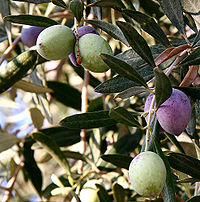
Photo from wikipedia
Abstract Grafting is an important horticultural technique used for many crop species. However, some scion/rootstock combinations are considered as incompatible due to poor graft union formation and subsequently high plant… Click to show full abstract
Abstract Grafting is an important horticultural technique used for many crop species. However, some scion/rootstock combinations are considered as incompatible due to poor graft union formation and subsequently high plant mortality. The early identification of graft incompatibility could allow the selection of non-viable plants before planting and would have a beneficial impact on research and development in the nursery sector. In general, visible phenotypes of grafted plants (size, root number, etc.) are poorly correlated with grafting success, but some studies have suggested that some polyphenols could be used as markers of graft incompatibility several months or years after grafting. However, much of the previous studies into metabolite markers of grafting success have not included all the controls necessary to unequivocally validate the markers proposed. In this study, we quantified 73 primary and secondary metabolites in nine hetero-grafts and six homo-grafted controls 33 days after grafting at the graft interface and in both the scion and rootstock woody tissues. Certain biomarker metabolites typical of a high stress status (such as proline, GABA and pallidol) were particularly accumulated at the graft interface of the incompatible scion/rootstock combination. We then used correlation analysis and generalized linear models to identify potential metabolite markers of grafting success measured one year after grafting. Here we present the first attempt to quantitatively predict graft compatibility and identify marker metabolites (especially asparagine, trans-resveratrol, trans-piceatannol and α-viniferin) 33 days after grafting, which was found to be particularly informative for homo-graft combinations.
Journal Title: Horticulture Research
Year Published: 2022
Link to full text (if available)
Share on Social Media: Sign Up to like & get
recommendations!